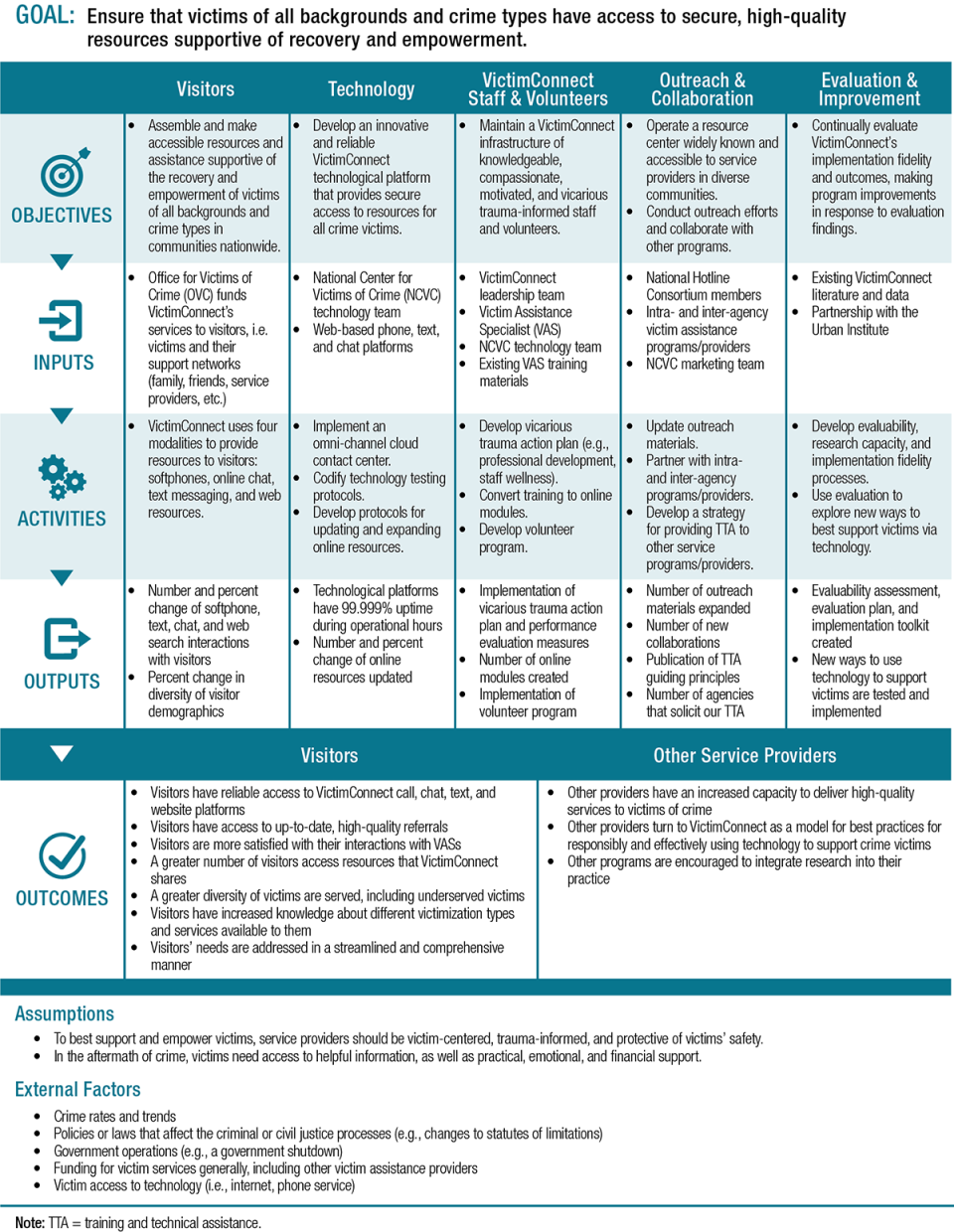Exhibit 3: VictimConnect Logic Model
This image is exhibit 3 of the article Evaluating Technology-Based Services for Victims of Crime.
GOAL: Ensure that victims of all backgrounds and crime types have access to secure, high-quality resources supportive of recovery and empowerment.
Visitors:
- Objective: Assemble and make accessible resources and assistance supportive of the recovery and empowerment of victims of all backgrounds and crime types in communities nationwide.
- Inputs: Office for Victims of Crime (OVC) funds VictimConnect’s services to visitors, i.e. victims and their support networks (family, friends, service providers, etc.).
- Activities: VictimConnect uses four modalities to provide resources to visitors: softphones, online chat, text messaging, and web resources.
- Outputs: Number and percent change of softphone, text, chat, and web search interactions with visitors. Percent change in diversity of visitor demographics.
Technology:
- Objective: Develop an innovative and reliable VictimConnect technological platform that provides secure access to resources for all crime victims.
- Inputs: National Center for Victims of Crime (NCVC) technology team. Web-based phone, text, and chat platforms.
- Activities: Implement an omni-channel cloud contact center. Codify technology testing protocols. Develop protocols for updating and expanding online resources.
- Outputs: Technological platforms have 99.999% uptime during operational hours. Number and percent change of online resources updated.
VictimConnect Staff and Volunteers:
- Objective: Maintain a VictimConnect infrastructure of knowledgeable, compassionate, motivated, and vicarious trauma-informed staff and volunteers.
- Inputs: VictimConnect leadership team. Victim Assistance Specialist (VAS). NCVC technology team. Existing VAS training materials.
- Activities: Develop vicarious trauma action plan (e.g., professional development, staff wellness). Convert training to online modules. Develop volunteer program.
- Outputs: Implementation of vicarious trauma action plan and performance evaluation measures. Number of online modules created. Implementation of volunteer program.
Outreach and Collaboration:
- Objective: Operate a resource center widely known and accessible to service providers in diverse communities. Conduct outreach efforts and collaborate with other programs.
- Inputs: National Hotline Consortium members. Intra- and inter-agency victim assistance programs/providers. NCVC marketing team.
- Activities: Update outreach materials. Partner with intra- and inter-agency programs/providers. Develop a strategy for providing TTA to other service programs/providers.
- Outputs: Number of outreach materials expanded. Number of new collaborations. Publication of TTA guiding principles. Number of agencies that solicit our TTA.
Evaluation and Improvement:
- Objective: Continually evaluate VictimConnect’s implementation fidelity and outcomes, making program improvements in response to evaluation findings.
- Inputs: Existing VictimConnect literature and data. Partnership with the Urban Institute.
- Activities: Develop evaluability, research capacity, and implementation fidelity processes. Use evaluation to explore new ways to best support victims via technology.
- Outputs: Evaluability assessment, evaluation plan, and implementation toolkit created. New ways to use technology to support victims are tested and implemented.
Outcomes:
Visitors:
- Visitors have reliable access to VictimConnect call, chat, text, and website platforms.
- Visitors have access to up-to-date, high-quality referrals.
- Visitors are more satisfied with their interactions with VASs.
- A greater number of visitors access resources that VictimConnect shares.
- A greater diversity of victims are served, including underserved victims.
- Visitors have increased knowledge about different victimization types and services available to them.
- Visitors’ needs are addressed in a streamlined and comprehensive manner.
Other Service Providers:
- Other providers have an increased capacity to deliver high-quality services to victims of crime.
- Other providers turn to VictimConnect as a model for best practices for responsibly and effectively using technology to support crime victims.
- Other programs are encouraged to integrate research into their practice.
Assumptions:
- To best support and empower victims, service providers should be victim-centered, trauma-informed, and protective of victims’ safety.
- In the aftermath of crime, victims need access to helpful information, as well as practical, emotional, and financial support.
External Factors:
- Crime rates and trends
- Policies or laws that affect the criminal or civil justice processes (e.g., changes to statutes of limitations)
- Government operations (e.g., a government shutdown)
- Funding for victim services generally, including other victim assistance providers
- Victim access to technology (i.e., internet, phone service)
Note: TTA = training and technical assistance.


